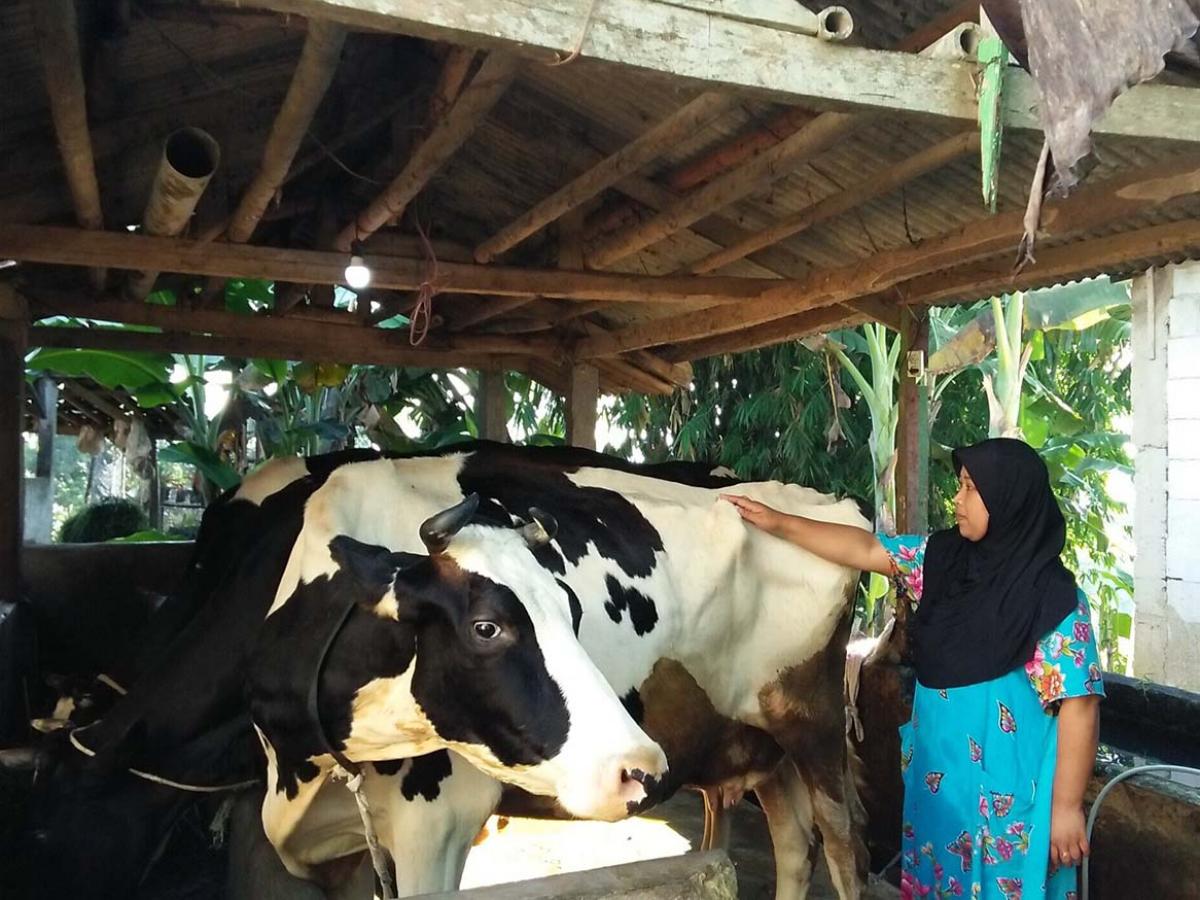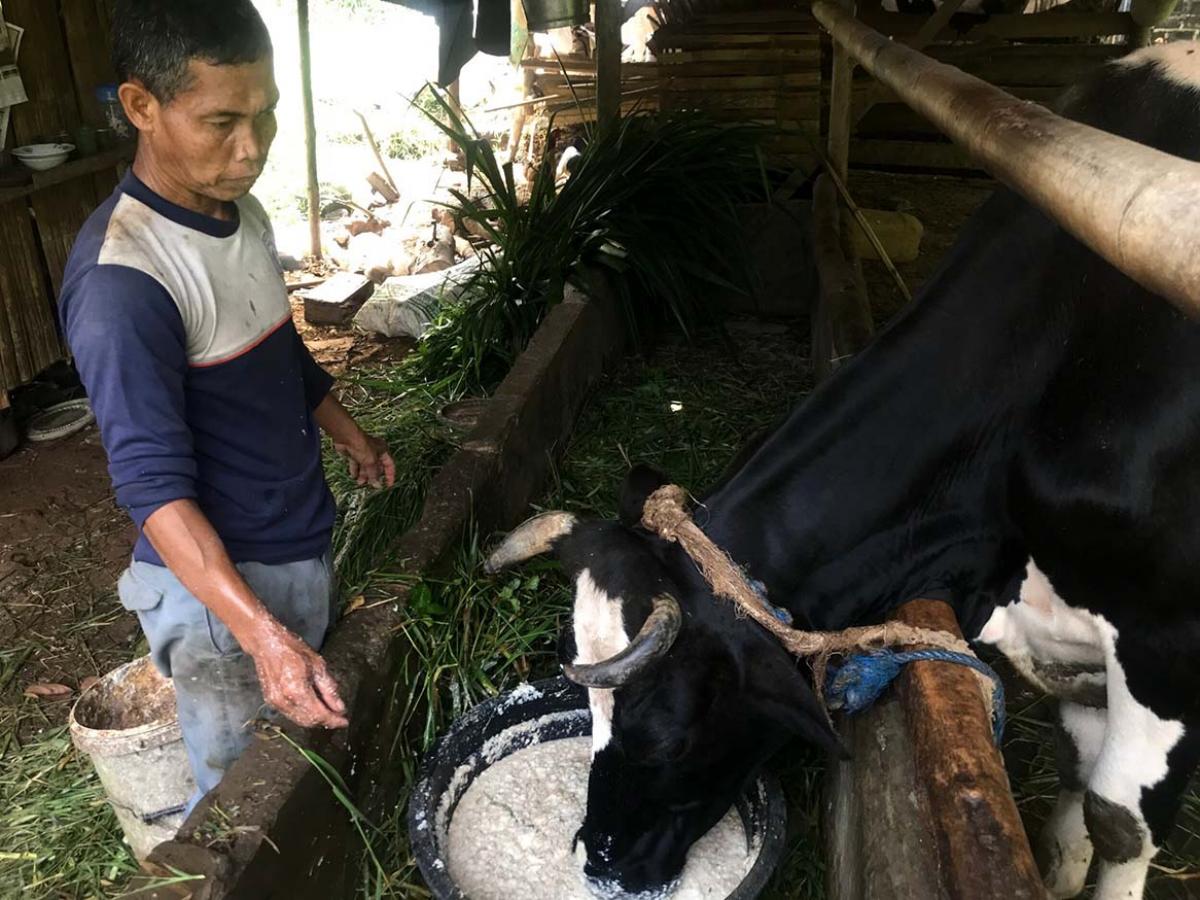IndoDairy Newsletter #2
Assessing a cow's body condition score
Attin Syahnurotin, Village Level Researcher (VLR) IndoDairy Bogor

Photo of Ibu Sanah from the Women's discussion group in Bogor learning how to body condition score her cow.
Ibu Sanah and her husband have been raising dairy cattle for about 20 years and had never assessed the body condition of their cows. Assessments of their cows were limited to visual signs if they were sick or if in oestrous or not.
Through the Women Discussion Group participants learnt the theory of body condition scoring and practice this on farm.
The importance of knowing a cow's body condition helps farmers pay more attention to feeding management and managing cow requirements. Assessment of body condition score can help understand if a cow looks thin, medium or fat. Body Condition Score (BCS) is changes over the lactation period such as: 1) Early lactation; 2) Mid-lactation and 3) Late lactation.
Determining the score of a cow's body condition helps farmers pay more attention to the cows nutritional needs during their lactation. "I had never assessed the body condition before, but after the activities of the Womenʼs Discussion Group I learnt to observe points on the cows body to measure condition which I can apply to my farm,” said Ibu Sanah.
Learning to determine the condition of the cow is quite easy when practiced to observe and understand the BCS scale of 1-5. After the topic on BCS the women in the discussion group learned to determine the BCS on farm and understood that the ideal body condition at calving and drying off is between 2.75 and 3.25.
Observations of cow's body condition helped Ibu Sanah and her husband arrange the feed needs for the cow to increase body condition before drying off for better health, reproduction and milk yield over her lifetime.
Healthy calves for good quality replacement stock
Muhammad Fauzi, Village Level Researcher (VLR) IndoDairy Pangalengan

Photo of Pak Ujang from KPBS Pangalengan with his calf.
Pak Ujang has faced many challenges and risks as a dairy farmer, particularly animal health problems and difficulties of finding forage during the dry season. Despite this, Pak Ujang has not given up on farming and remains excited about being in the dairy industry over the past 20 years.
To help overcome his challenges, Pak Ujang often volunteers to participate in programs that are held both from cooperatives and in the wider dairy industry, to help improve his knowledge and apply it back on farm as well as transfer information to other farmers in his surrounding district.
In Pangalengan there is an aim that a calf should be born on a farm every year. However, this can be difficult for some farmers who cannot manage newborn calves well. Calf management was discussed during the IndoDairy groups and covered feeding and nutrition of calves, correct handling practices and housing that supports the growth of calves.
Pak Ujang has applied new practices to manage calves which includes providing dried concentrate gradually at the age of 14 days and drinking water to prevent dehydration. He has said the calves now look healthier and more active and have reached their target weights quicker. Pak Ujang hopes that in the future these calves will result in better lactation cows, and in turn also give birth to better calves.
Treatment of flies using simple organic materials on farm
Elis Diah Sri Rahayu, Village Level Researcher (VLR) IndoDairy Garut.

Photo of Ibu Cucu from a discussion group in Garut KPGS spraying her cow to prevent and treat flies.
In the rainy season the population of flies increases dramatically on farm. The presence of flies interferes with cow comfort, and can cause diseases which is dangerous for livestock.
The topic of pest management and flies was a high priority for the farmers involved in the IndoDairy discussion group in Garut. Many farmers in the group were impacted by flies during the afternoon milking, and enthusiastic to discuss methods to prevent and control fly pests.
During the discussion several methods to control flies were presented. Bu Cucu was interested to apply one of the methods of fly repellent which involves the simple use of a natural organic liquid. This can be made easily with ingredients of tobacco, mahogany seeds and shampoo as a repellant by spraying directly on the flies. When mahogany seeds are difficult to obtain, it can be replaced by gait leaves. According to Bu Cucu, the use of the liquid spray has helped to reduce the population of flies during the milking process.
A farmer from the Babakan Jolok discussion group, Pak Dede has also adopted fly control methods using organic materials by replacing mahogany seeds using kipahit leaves. He has said that the use of organic mixed materials has helped to repel flies on the farm.
Various topics have been discussed in the IndoDairy discussion groups which have been beneficial for farmers because they feel more aware of different practices to manage their farms better.
Increasing milk production by improving dry matter intake
Rio Muhammad Fauzan, Village Level Researcher (VLR) IndoDairy Cianjur

Photo of Pak Rudi from the Cianjur discussion group who benefited from information on feed management.
Having cows with high milk production is the dream of every dairy farmer. With higher milk production, farmers expect to earn a higher income. Unfortunately, not every farmer has the awareness or information to improve production, which is seen from the lack of good feeding management.
However, Pak Rudi a farmer from Garung 2 has changed his feeding management practices and seen results after participating in the activities from the IndoDairy discussion topic on nutrition. Pak Rudi has been a member of the cattle farmer's cooperative for 10 years with one cow. Although Pak Rudi only has one cow, he hopes to maintain sufficient income from producing milk. However, it has been difficult for him to achieve this goal with low production and limited knowledge of feeding and nutrition. At times Pak Rudi has considered stopping dairy farming.
Fortunately Pak Rudi joined the IndoDairy discussion group and gained good insights about improving the management of dairy cows, including nutrition. Pak Rudi took on the information of ways to increase dry matter intake to increase milk production.
Previously in his daily feeding practice, he fed 30kg elephant grass, 2kg bran and 6kg of tofu waste. This was a total of 9.2kg dry matter (DM) which produced 8 litres milk/day. Now he increased the feed intake by feeding 40kg of elephant grass, added 4kg of concentrate, 3kg bran and 15kg of tofu waste. This increased DM intake to 16.7kg DM resulting in an increase to 15 litres milk/day. He realised that proper feeding management impacts on milk production as well as cow performance, where the additional milk covered the increased cost of the feed.
Pak Rudi was very grateful to have gained this understanding as way to help make improvements to his dairy farming business. He was very pleased that the changes he made had a positive result.
Manure management: using dairy cattle manure as organic fertiliser
Rizky Febrianggia Village Level Researcher (VLR) IndoDairy Cisarua

Photo of Pak Miftah from Cisarua spreading manure on this forage plot.
Sources of environmental pollution from farms, such as manure need to be handled in a way to ensure sustainability of the industry into the future and preserve natural resources in the surrounding communities.
In Cisarua, there have been public complaints about the adverse impacts of dairy farming from the improper handling of manure which is discharged into nearby rivers. Waste from dairy farms include faeces, urine, wasted feed, milk and wash water from cleaning the dairy shed causing pollution to river systems and down-stream environmental problems.
Monthly discussion groups have been helpful for farmers to understand options of waste treatment and re-use of manure as fertiliser that can be applied on their land or sold to vegetable and ornamental farmers as additional income.
After the discussion topic on manure management Pak Miftah used the manure on his farm as organic fertiliser to increase the fertility of his land by applying nitrogen, phosphorus and potassium. The manure was first dried on the farm, then transported in bags and spread back on the land. The results after applying the manure is that Pak Miftah observed a faster growth rate of the forage allowing him to cut the grass more frequently from the better fertility. In addition he is also exploring ways to sell excess manure to vegetable and flower farmers in the Cisarua area. Re-use of manure not only has production benefits but also is a way to minimise the nutrient run off into waterways, reducing the environmental impact.
